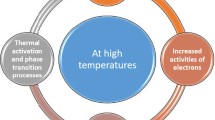Abstract
Our recent progress in elevated temperature nanoindentation is reviewed, with an emphasis on the study of discrete events (i.e., pop-in phenomena) observed during nanoindentation. For crystalline materials the incipient plasticity problem is associated with the nucleation of dislocations, an effect which we show to be significantly temperature dependent. For metallic glasses it is the operation of individual shear bands beneath the indenter that gives rise to pop-in events; here we also show this to be a temperature dependent phenomenon. Approaches to extract the activation volume and energy of defects involved in plastic flow beneath the indenter are also briefly described.
Similar content being viewed by others
References
S. Suresh, T. G. Nieh and B. W. Choi, Scripta Mater. 41, 951 (1999).
D. F. Bahr, D. E. Kramer and W. W. Gerberich, Acta Mater. 46, 3605 (1998).
Y. L. Chiu and A. H. W. Ngan, Acta Mater. 50, 1599 (2002).
W. W. Gerberich, J. C. Nelson, E. T. Lilleodden, P. Anderson and J. T. Wyrobek, Acta Mater. 44, 3585 (1996).
C. A. Schuh and T. G. Nieh, J. Mater. Res. 19, 46 (2004).
C. A. Schuh and T. G. Nieh, Acta Mater. 51, 87 (2003).
C. A. Schuh and A. C. Lund, J. Mater. Res. 19, 2152 (2004).
S. A. Syed-Asif and J. B. Pethica, Phil. Mag. A76, 1105 (1997).
D. F. Bahr, D. E. Wilson and D. A. Crowson, J. Mater. Res. 14, 2269 (1999).
D. E. Kramer, K. B. Yoder and W. W. Gerberich, Phil. Mag. A81, 2033 (2001).
J. Xia, C. X. Li and H. Dong, Mater. Sci. Eng. A354, 112 (2003).
B. D. Beake and J. F. Smith, Phil. Mag. A82, 2179 (2002).
S. A. S. Asif and J. B. Pethica, Journal of Adhesion 67, 153 (1998).
A. C. Lund, A. M. Hodge and C. A. Schuh, Appl. Phys. Lett. 85, 1362 (2004).
C. A. Schuh, A. C. Lund and T. G. Nieh, Acta Mater. 52, 5879 (2004).
F. Spaepen, Acta Metall. 25, 407 (1977).
A. S. Argon, Acta Metall. 27, 47 (1979).
J. Megusar, A. S. Argon and N. J. Grant, Mater. Sci. Eng. 38, 63 (1979).
Acknowledgments
This work was supported by several sources, including: the Office of Naval Research, Grant Nos. N00014-01-1-0808 and N00014-04-1-0669, the Army Research Office, Grant No. DAAD19-03-1-0235, and the University of California, Lawrence Livermore National Laboratory under contract with the US Department of Energy, Contract No. W-7405-Eng-48.
Author information
Authors and Affiliations
Rights and permissions
About this article
Cite this article
Schuh, C.A., Mason, J.K., Lund, A.C. et al. High Temperature Nanoindentation for the Study of Flow Defects. MRS Online Proceedings Library 841, R4.8 (2004). https://doi.org/10.1557/PROC-841-R4.8
Published:
DOI: https://doi.org/10.1557/PROC-841-R4.8




